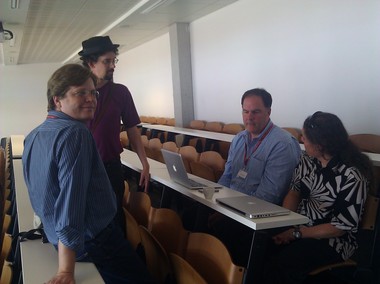First, as of this writing: I’m at the GAMBIT Summer Summit here at MIT, which runs today and is being streamed live. Do check it out if video game research interests you.
A few days ago, I was at the Foundations of Digital Games conference in Bordeaux. On July 1 I presented the first conference paper on Curveship since the system has been released as free software. The paper is “Curveship’s Automatic Narrative Style,” which sums up or at least mentions many of the research results while documenting the practicalities of the system and using the current terminology of the release version.

Noah Wardrip-Fruin, Malcolm Ryan, Michael Young (next year’s FDG local organizer) and Michael Mateas in between sessions at FDG 2011.
At FDG, there was a very intriguing interest in focalization, seen in Jichen Zhu’s presentation of the paper by Jichen Zhu, Santiago Ontañón and Brad Lewter, “Representing Game Characters’ Inner Worlds through Narrative Perspectives” and in the poster “Toward a Computational Model of Focalization” by Byung-Chull Bae, Yun-Gyung Cheong, and R. Michael Young. (Zhu’s work continues aspects of her dissertation project, of which I was a supervisor, so I was particularly interested to see how her work has been progressing.) Curveship has the ability to change focalization and to narrate (textually) from the perspective of different characters, based on their knowledge and perceptions; this is one of several ways in which it can vary the narrating. I’ll be interested to see how others continue to explore this aspect of narrative.
Before FDG was Digital Humanities 2011 at Stanford, where I was very pleased, on June 22, to join a panel assembled by Rita Raley. I briefly discussed data-driven poetic practices of different sorts (N+7, diastic writing, and many other forms) and presented ppg256 and Concrete Perl, which are not data-driven. I argued that as humanists we should be “digging into code” as well as data, understanding process in the new ways that we can. It was great to join Sandy Baldwin, Noah Wardrip-Fruin, and John Cayley on this panel, to discuss code and poetry with them, and to hear their presentations.


Nice post. I read your Bordeaux paper about Curveship – great stuff. I will try to track down Zhu’s presentation with his colleagues.
Interesting points. Just out of curiosity, is interactivity compatible with your ppg approach, or are you committed to unsupervised generation?
If I may nitpick… When I look at (for example) ppg256-1, things like “cococacamamadebapabohamolaburatamihopodito” sure look like data, and they clearly play an important part of the words that emerge. I think you mean something like “hand-authoring linguistic resources rather than exploiting existing corpora”.
I’m interested in what you mean by this. Have you written it up somewhere?
Edde, thanks for your comment. I’ve enjoyed your charNG character n-gram generator and have meant to post something about it.
All of the ppg programs are non-interactive; they aren’t machine learning systems so neither supervised nor unsupervised learning is involved. I don’t have any distaste for interactive systems, but there is something of a myth that an interesting system has to be interactive. It seems to me that these super-small systems do something poetic without being interactive.
The ppg256 programs do include data and, as I discussed some at Stanford, parameters as well. By saying that they aren’t “data-driven,” I meant to indicate that they aren’t like machine learning systems that work by being directly trained on data, by being pointed at corpora and documents. Many of the ppg256 programs and “Sea and Spar Between,” which I wrote with Stephanie Strickland, did involve computer and human analysis of existing corpora, but the source texts in these cases were structured, curated, etc. in many non-automatic ways.
I don’t have any paper publication covering the same topic as my Stanford talk, but I’ve written a bit throughout the years – and am writing more currently – on this question of the humanistic study of code. For example:
“A Box, Darkly: Obfuscation, Weird Languages, and Code Aesthetics” by Michael Mateas and Nick Montfort.
And I have a paper on the ppg series:
“The ppg256 Series of Minimal Poetry Generators,” Nick Montfort.
Nah, I wasn’t hating, about half my generators are non-interactive. I was just thinking if I were to write such a program myself I’d try to save characters by prompting the user for data rather than storing it in the program.
Maybe in the digital humanities and e-poetry communities, I’m not familiar with those. But if you look at the proceedings of ACL or AAAI, the overwhelming amount of research seems to occur in non-interactive systems. And some of the most interesting research (in my opinion) is being done with interactive systems in relatively non-mainstream communities like SIGDial (dialogue systems) or HRI (human-robot interaction). Lots of inspiration there for poetry generators, both interactive and non.
thx for the papers!
Edde, I’d be interested to know about some of these interesting interactive systems from non-mainstream communities such as the ones you mention. I’m sure there is fascinating work happening there.
The AAAI workshops and symposia that I’ve been to, which are more focused on the topics we’re discussing (e.g., Intelligent Narrative Technologies) have actually had a good number of interactive systems in play.
I’ve been to the main ACL conference and gave an invited talk at NAACL two years ago. There is a definite preference for non-interactive systems there, yes.